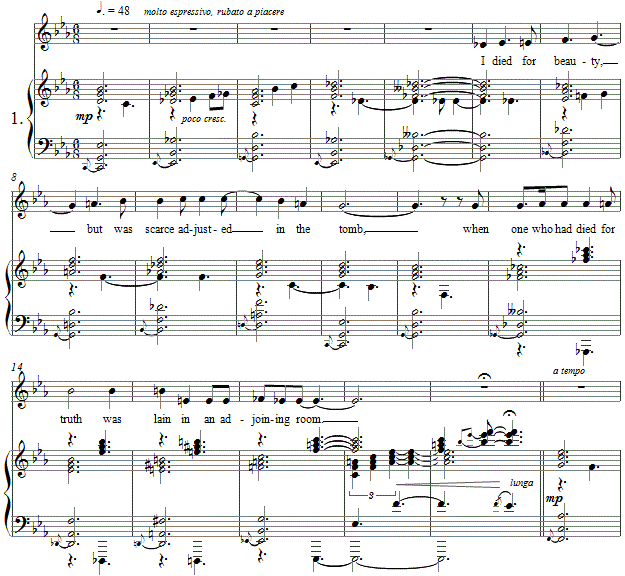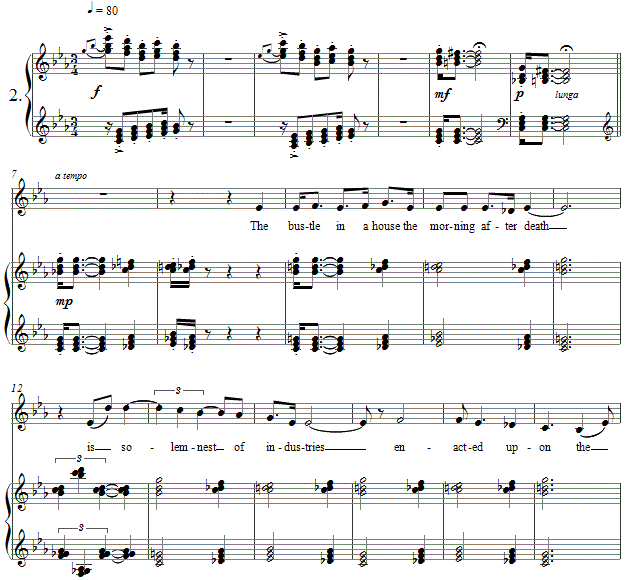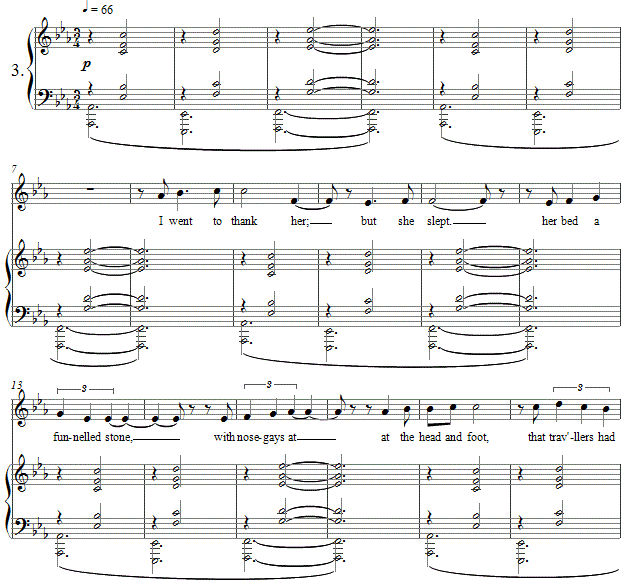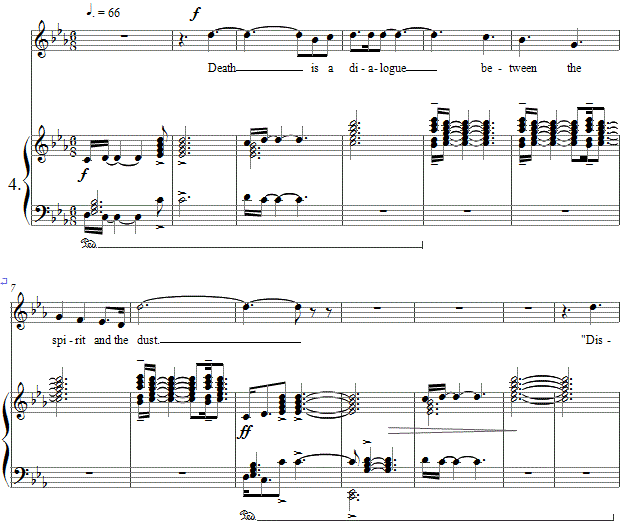Music and Texts of GARY BACHLUND
Vocal Music | Piano | Organ | Chamber Music | Orchestral | Articles and Commentary | Poems and Stories | Miscellany | FAQs
Of Time and Eternity - (2010)
Emily Dickinson
for mezzo soprano and piano
in memory of Ana María Fagundo
i. I died for beauty - [ 3 pages, circa 3' 30" ]
I died for beauty, but was scarce
Adjusted in the tomb,
When one who died for truth was lain
In an adjoining room.
He questioned softly why I failed?
“For beauty,” I replied.
“And I for truth,—the two are one;
We brethren are,” he said.
And so, as kinsmen met a night,
We talked between the rooms,
Until the moss had reached our lips,
And covered up our names.
ii. The bustle in a house - [ 2 pages, circa 1' 50" ]
The bustle in a house
The morning after death
Is solemnest of industries
Enacted upon earth,—
The sweeping up the heart,
And putting love away
We shall not want to use again
Until eternity.
iii. I went to thank her - [ 2 pages, circa 2' 30" ]
I went to thank her,
But she slept;
Her bed a funnelled stone,
With nosegays at the head and foot,
That travellers had thrown,
Who went to thank her;
But she slept.
’T was short to cross the sea
To look upon her like, alive,
But turning back ’t was slow.
iv. Dialogue - [ 3 pages, circa 2' 25" ]
Death is a dialogue between
The spirit and the dust.
“Dissolve,” says Death. The Spirit, “Sir,
I have another trust.”
Death doubts it, argues from the ground.
The Spirit turns away,
Just laying off, for evidence,
An overcoat of clay.[ 10 pages, circa 10' 15" ]
Emily Dickinson
While composing these settings, next to me was a volume of poems by poet, Ana María Fagundo, which are entitled in both Spanish and English, Materia en Olvido, Matter in Oblivion (2009), published by Micromeria, Ediciones Idea. It is a bilingual edition, English on the left side and the original Spanish on the right. The English translations are by the poet's collaborator, Philip O. Gericke. Ana died this year, and in this edition which she had sent to me from Madrid, she wrote -- "For you, Gary, this [ and an arrow to the title ] in the two languages I love: the language of Machado and the language of Emily Dickinson."
With her permission, I set a text from this collection to music for her, Almendros en flor, as well as three texts from earlier in her work, as Tres Canciones de Ana María Fagundo. For her admiration of "the language of Emily Dickinson," I chose to set these texts as an "in memoriam" for her, and as my thanks to her work and life.
The opening text is Dickinson's imagined scene enacted between two of the newly dead. A range of minor chords moves gently, yet broadly away from a seeming C minor, brightening into polytonal, major chords as at measure fourteen, with the second actor's appearance in the scene. The setting rises to fortissimo and recedes again into a play off for piano alone, as the voice is stilled.
The "bustle in a house" is announced in bright syncopation and opposite motion, before a more somber mood takes hold. The setting moves between the two as does the moods of a house whose family mourns and yet must deal with much in that time. As the first setting ends in a somber C minor 9, this settings ends weakly in a lighter E flat major.
The dirge is a four measure ground bass, which repeats without development throughout the setting, its cadence on an open-ended F minor seven with added major second and sixth. Over this simple three chord succession, the vocal line tells the story of one who grieves, and ends without harmonic resolution.
The final setting is an aggressive stance on the part of "death" opposing the more lyrical statement of trust. Harmonically static, five note chords insist on the forte of death, yielding to a harmonically static E flat major seven, after which the setting reprises the opening song's theme and its chromatic touches based on C minor finally yield to a pianissimo B flat with repetition of the single word, "trust."
Ana María Fagundo
Ana María Fagundo (1938-2010) was Professor Emeritus of Spanish in the Department of Hispanic Studies at University of California, Riverside, whose work as a poet spans decades, in California as in Madrid and Tenerife. Studying at the University of Redlands after her studies in the Canary Islands, she earned her Ph.D. in comparative literature with expertise in English, American and Spanish literature, published many collections of her works since 1965, some in bilingual editions, and founded and edited a poetry journal, Alaluz, until her retirement in 2001. Her passionate interest in Dickinson drove her to publish Vida y obra de Emily Dickinson, Madrid, Alfaguara, 1973, and lasted a lifetime.
The score for Of Time and Eternity is available as a free PDF download, though any major commercial performance or recording of the work is prohibited without prior arrangement with the composer. Click on the graphic below for this piano-vocal score.





